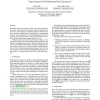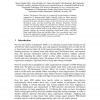1715 search results - page 2 / 343 » How Space Structures Language |
POPL
2000
ACM
13 years 9 months ago
2000
ACM
Distributed-memory programs are often written using a global address space: any process can name any memory location on any processor. Some languages completely hide the distincti...
CORR
2006
Springer
13 years 5 months ago
2006
Springer
The organization and mining of malaria genomic and post-genomic data is important to significantly increase the knowledge of the biology of its causative agents, and is motivated,...
EDM
2009
13 years 3 months ago
2009
The purpose of this study is to empirically reveal strategies of students' organization of learning-related digital materials within an online personal information archive. Re...
IIE
2007
13 years 5 months ago
2007
How do we teach children to express and communicate ideas in a formal and informal mode? What type of language do they need in a concrete context? How should they determine a prope...
DLT
2009
13 years 3 months ago
2009
A famous theorem of Kuratowski states that, in a topological space, at most 14 distinct sets can be produced by repeatedly applying the operations of closure and complement to a gi...


